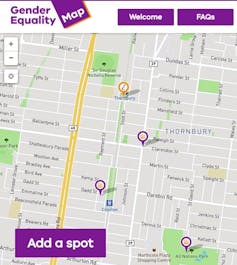Nicole Kalms at The Conversation: “Inequity in cities has a long history. The importance of social and community planning to meet the challenge of creating people-centred cities looms large. While planners, government and designers have long understood the problem, uncovering the many important marginalised stories is an enormous task.
ion: “Inequity in cities has a long history. The importance of social and community planning to meet the challenge of creating
Technology – so often bemoaned – has provided an unexpected and powerful primary tool for designers and makers of cities. Crowd-mapping asks the community to anonymously engage and map their experiences using their smartphones and via a web app. The focus of the new Gender Equality Map launched today in two pilot locations in Melbourne is on equality or inequality in their neighbourhood.
How does it work?

Crowd-mapping generates geolocative data. This is made up of points “dropped” to a precise geographical location. The data can then be analysed and synthesised for insights, tendencies and “hotspots”.
The diversity of its applications shows the adaptability of the method. The digital, community-based method of crowd-mapping has been used across the globe. Under-represented citizens have embraced the opportunity to tell their stories as a way to engage with and change their experience of cities….(More)”